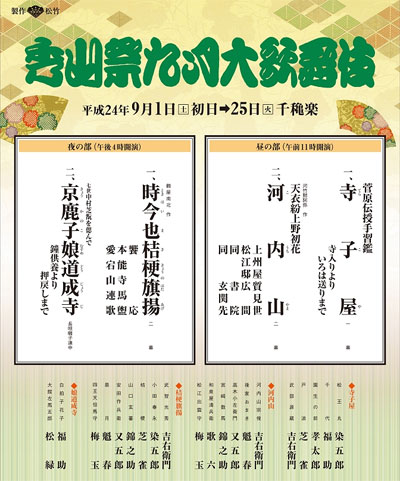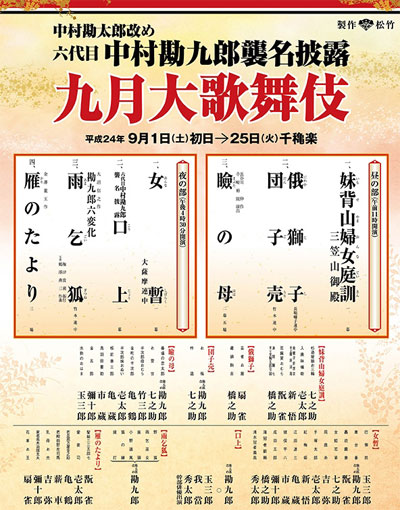| SEPTEMBER 2012 |
|
3 shows in T˘ky˘ (Shinbashi Enbuj˘, National Theatre), 2 in ďsaka (Sh˘chikuza), 1 show in Ky˘to (Minamiza) and 1 tour (Western Provinces)!
|
| Shinbashi Enbuj˘ (T˘ky˘) |
| Dates | 1 ~ 25 September 2012 (Shűzan Matsuri Kugatsu ďkabuki) Shűzan's Festival September Grand Kabuki |
| MatinÚe | |
| Evening | |
| Casting |
Nakamura Kichiemon, Nakamura Baigyoku, Nakamura Shibajaku, Nakamura Fukusuke, Nakamura Kaishun, Kataoka Takatar˘, Nakamura Kinnosuke, Nakamura Karoku, Nakamura Matagor˘, Onoe Sh˘roku, Ichikawa Komaz˘, Nakamura Kash˘, Nakamura Matsue, Sawamura Yoshijir˘, ďtani Keiz˘, Sawamura S˘nosuke, Band˘ Kametoshi, Matsumoto Kingo, ďtani Hirotar˘, ďtani Hiromatsu, Nakamura Tanenosuke, Nakamura Hayato, Nakamura Yonekichi, Nakamura Kichinosuke |
| Comments |
This is the 6th edition in T˘ky˘ of a special program called "Shűzan Matsuri" (the festival of Shűzan), which is produced at the Shinbashi Enbuj˘ to commemorate the great actor Nakamura Kichiemon I, whose's haimy˘ was Shűzan. The star of this program is his adopted son Nakamura Kichiemon II.
|
 |
| Sh˘chikuza (ďsaka) |
| Dates | 1 ~ 25 September 2012 (Kugatsu ďkabuki) September Grand Kabuki |
| MatinÚe | |
| Evening |
Amagoi Gitsune (Kankur˘ Rokuhenge) |
| Casting |
Nakamura Kankur˘, Band˘ Tamasabur˘, Nakamura Kanjaku, Nakamura Senjaku, Nakamura Hashinosuke, Kataoka Gat˘, Kataoka Hidetar˘, Band˘ Yajűr˘, Nakamura Shichinosuke, Band˘ Takesabur˘, Kataoka Ichiz˘, Kataoka Kamez˘, Nakamura Kikaku, Kamimura Kichiya, Band˘ Shinsha, Nakamura Kazutar˘, Band˘ Shingo |
| Comments |
Nakamura Kankur˘ VI celebrates his shűmei in ďsaka at the Sh˘chikuza!
|
 |
| Kabuki Tour in the western provinces | |
| Dates | 31 August ~ 26 September 2012 |
| Program |
Kabuki no Mikata |
| Casting |
Ichikawa Ukon, Ichikawa Monnosuke, Ichikawa Emisabur˘, Ichikawa Emiya, Ichikawa En'ya, Ichikawa Juen, Ichikawa K˘tar˘ |
| Comments |
|
| National Theatre (T˘ky˘) |
| Dates | 1 ~ 2 September 2012 (Matsuo-juku Kodomo Kabuki) Matsuo Academy of Kabuki ~ Kabuki for Kids Performance |
| Program |
Ume no Yoshibŕ Nagauta Suehirogari |
| Comments |
The Matsuo-juku Kodomo Kabuki [website in Japanese] is a kodomo shibai troupe, founded in ďsaka in 1988 by Matsuo Hazue, the wife of Matsuo Kuniz˘ (1899~1984), whose name is closely associated to the Matsuo Artistic Awards (Matsuo Gein˘ Sh˘). The troupe is now led by Matsuo Hazue's daughter Matsuo Hideko. The troupe celebrates its 25th anniversary in 2012! |
|
|||
| Dates | 28 ~ 30 September 2012 (Koten he no Izanai) Invitation to the Classics |
||
| Program |
Opening Talk Hann˘ Shakky˘ |
||
| Casting | |||
| Comments |
An original program, which mixes N˘ (second item in the program) and Kabuki Buy˘ (third item in the program). The opening talk is done by the young Kabuki star Ichikawa Ebiz˘.
|
||
|
|
| Contact | Main | Top | Updates | Actors | Plays | Playwrights | Programs | Links | FAQ | Glossary | Chronology | Illustrations | Prints | Characters | Derivatives | Theaters | Coming soon | News |